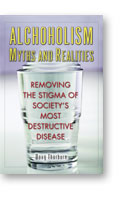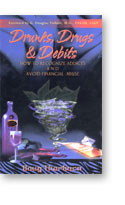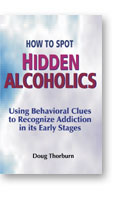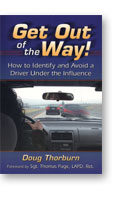 |
July 2010 / Issue No. 56
For those who read my comment in the last issue about lacking inspiration, well...I got inspired.
Viewing the news through the lens of alcohol and other-drug addiction
It's good to be back in full swing following "tax season". We hope you enjoy this issue. You may wish to take the opportunity to look at our books at www.amazon.com or www.galtpublishing.com for gift-giving ideas. We’re proud of the fact that 39 of 51 collective reviews at Amazon.com give the books five-star ratings (and you are welcome to add to those reviews!).
|
 |
|
Welcome to the Thorburn Addiction Report. Each month in which we interpret the news through the lens of alcohol and other drug addiction. Each month we bring you several sections, including:
- Top Story of the month along with runners up, persons under watch, enablers, disenablers and more
- Review or Public Policy Recommendation of the month
- Dear Doug in which a recent letter to "Dear Annie" or other "help" column is rewritten, with responses given from the unique perspective that alcohol or other drug addiction best explains the misbehaviors described
- Alcoholic Myth-of-the-Month
- Alcoholic Antic-of-the-Month, usually where someone deserves the Darwin Award, but lived.
There is something for everyone!
©
Doug Thorburn. All rights reserved.
|
|
|
The blog is now reopened to your comments. We’ll be interested in any thoughts you, our loyal readers, may have.
By the way, call us (800-482-9424) for deals on books you won’t be able to refuse. (They are also available, of course, at www.amazon.com or www.galtpublishing.com.) They make a terrific gift to teens and anyone thinking about becoming professionally or romantically involved with someone else! (including other drivers, landlords, tenants, employers, employees, neighbors...)
Order Books Here
|
|
|

Lonnie David Franklin, Jr., Now Linked to The Grim Sleeper Killings, Again Proves we can’t Predict how Destructive an Addict may Become—or When
It was an open secret that Lonnie David Franklin, Jr., who fronted as a neighborhood mechanic, dismantled stolen cars and sold the parts from his big backyard in South Los Angeles. However, no one thought he was capable of murder, must less serial murder.
Franklin was either a “beer drinking buddy” or on the wagon. He was at times a father figure to adolescent women and at others a pervert talking about nothing but sex and drugs. He was always willing to help out a neighbor, except when he was so paranoid he wouldn’t even go to his street mailbox without locking the front door.
Some of his neighbors were not only disbelieving, but figured that since “Lonnie couldn’t have done this” he was being set up by the LAPD. Locals described him as a “kind and compassionate neighbor who volunteered in the community, helped elderly residents of the block and fixed their cars for free.” To those who viewed him as such a gentleman, it would seem contradictory that he could be linked, via DNA evidence resulting from a “familial search” of prison inmates (authorities tracked him down from his incarcerated son’s DNA), to the murders of at least 10 women over 25 years. However, once we understand that alcoholism causes erratically destructive behaviors usually interspersed with productive and caring ones, the seeming contradiction disappears.
Relatively small transgressions such as sounding like a pervert or oddball misbehaviors such as locking the front door before fetching the mail more often than not prove to be clues to alcoholism. As pointed out in Drunks, Drugs & Debits: How to Recognize Addicts and Avoid Financial Abuse in the section describing the tragic murder-suicide of comedian Phil Hartman by his wife Brynn:
We cannot predict how destructive the behavior of a practicing addict may become.
The case of Lonnie David Franklin, although set in a very different environment from the one the Hartman’s lived, is really no different. Brynn Hartman proved she had two faces. As one of Franklin’s neighbors put it, “He’s a man with two faces.” Addicts, regardless of their position in society, are really all the same.
CLICK TO ORDER DOUG THORBURN'S BOOKS NOW!
|
Runners-up for top story of the month:
Mel Gibson, 54, whose clue to insobriety included a tirade in which he told his Russian girlfriend, Oksana Grigorieva, 39, “If you get raped by a pack of n***ers, it will be your fault,” because she apparently looked too sexy. By many accounts he’s outdone his previous outburst, for which he made “Top Story” in the August 2006 edition of TAR, which not only described Gibson’s arrest, but also explained why relapses are so darned common in alcoholics. At the time Gibson said that pain is a necessary precursor to change. He admitted he was “completely out of control” when he was arrested and was “deeply ashamed” for having driven when he “should not have” and for exhibiting “belligerent behavior.” It’s all the same, Mel. You relapsed, yet again. It’s time to get serious about getting and staying sober before you destroy your life and, worse, the life of someone close to you or some stranger on the road. You’ve still got a chance to show the stuff that recovering addicts are made of. Four years ago I bet that your ultimate amends, should you get and stay sober for five or ten years, would go down in history as one of the most generous ever to those whom the addict in you so maliciously maligned. I’d really like to win that bet.
Rod Blagojevich and his wife Patti who, according to testimony of Internal Revenue Service agent Shari Schindler at his federal corruption trial, were buried under more than $200,000 in consumer debt when the former Illinois governor was arrested. Their extraordinary spending spree included more than $400,000 on clothes (just clothes!) mainly for themselves—and not for their children—in the seven years ending in December 2008. Blago spent over $205,000 alone with Oxxford, a high-end custom suit tailor. One might ask, what about spending on cars? He and his family relied on state cars and drivers. What about his legal bills? His campaign account is covering those. What about Rolex watches? I suspect he might have received any he has as “gifts.” Gee, I wonder why the IRS agent is testifying?
Bret Carr, who filed a lawsuit against a number of staff members and advisers to his late mother, Miami heiress Gail Posner, alleging “dark intrigue.” When Ms. Posner died in March at age 67, her Chihuahua Conchita and two other (less-favored) dogs inherited the right to live in her $8.3 million Miami Beach mansion, prepaid with a $3 million trust fund. Carr claims the targets of the lawsuit drugged his mother with pain meds and conspired to steal her assets by inducing her to change her will and to get her to hire a publicist to promote Conchita as “one of the world’s most spoiled dogs,” with a four-season wardrobe, full-time staff and diamond jewelry (which explains, I suppose, why so large a trust fund, complete with house was required to care for the dogs). Now, what could possibly explain something that wouldn’t be believed if it was fiction? How about this: Mr. Carr explains that, although his relationship with his mother is portrayed in the lawsuit as a bit unstable, they had a close relationship during “the sober phases of her life”? Or that her father, corporate takeover artist Victor Posner, had a “checkered” career that included a no contest charge to tax evasion charges in 1987? Or that the clan has, according to The Wall Street Journal, “long been haunted by drug and alcohol addiction [and] claims of sexual abuse allegedly committed by Victor Posner”? The case is reminiscent of Leona Helmsley, who also left a fortune to her dog and whose story is briefly recounted in the “under watch” section of the September 2007 issue of TAR.
Under watch:
In an early 2009 piece on white collar crime, The Economist magazine mentioned something those who have read my books would predict: “Many [Club Fed and other white collar] prisoners suddenly discover, post-conviction, that they had a drinking problem….” I would add that those who don’t figure this out might benefit from greater introspection. In the spirit of The Economist’s discovery, a recent case follows for which the evidence of alcoholism is in the alleged crime itself.
Crony capitalist Alfred R. Villalobos, who has been named in a state influence-peddling lawsuit, filing for bankruptcy in Nevada with almost $5 million owed to Nevada casinos in addition to other debts. Villalobos was a deputy mayor of Los Angeles for five months in 1993 and a board member of CalPERS, California’s giant pension fund, from 1993 to 1995. Over the last dozen years, Villalobos took in more than $50 million in commissions for brokering billion dollar deals between investment managers and CalPERS, as well as other government pension funds. One can only imagine how prolific a gambler, as the Attorney General’s office put it, he must be. The AG office is opposing the Nevada bankruptcy filing, arguing that Villalobos’ assets, which include “16 residences, 21 bank accounts, a fleet of luxury automobiles and artwork,” should remain with a California-based receiver authorized two weeks before the bankruptcy filing. One might hypothesize that such extravagance may have been fueled by alcoholism, which also could explain some of the grandiose promises made by politicians to their labor union cronies, resulting in a half-trillion dollar shortfall in California state government’s all-too-generous pension system.
Alcoholic victims of the month:
A 6-month-old baby, whose parents, Patrick Fousek, 38 and Samantha Tomasini, 20, tried to sell for $25 outside a Wal-Mart in Salinas, CA. What drug could possibly impel not just one parent but both to try to sell their child at a Wal-Mart? There’s really only one. When officers later arrested the couple at their home, they appeared to be high on methamphetamine and the house was in disarray (and for this to be mentioned by police we can’t imagine how great the disarray must have been). They were charged with child endangerment and being under the influence of narcotics. Fousek was also charged with—are you ready?—violating probation. I’m shocked, just shocked.
Some 300 current and retired FBI, DEA and ICE agents, who collectively invested tens of millions of dollars of retirement money in what turned out to be a Ponzi scheme, run by Florida “retirement investment adviser” Kenneth Wayne McLeod, 48, who was found dead of an apparent self-inflicted gunshot wound. McLeod used one of the classic lines: “I know …. (this federal agent, that federal agent)” when soliciting business. FBI Director Robert S. Mueller was among those he told everyone he not only “knew”; he was his “friend.” One retired agent told reporters, “The guy was a real charmer. He would say that he and Bob were the best of friends and that Bob and his wife used to stay at his place all the time.” An FBI spokesman said that Mueller “had no personal or professional relationship with Mr. McLeod.” McLeod offered some investments that appeared to be safe, while others—government bonds reportedly paying 8 to 10 percent—were obviously fraudulent. Oh, and he paid himself well, which included lavish entertainment such as annual trips to wherever the Super Bowl was each year “for himself and 40 friends.” Note to federal agents: all you had to do to rouse your suspicions and save yourselves millions was to read pages 44-45 of How to Spot Hidden Alcoholics: Using Behavioral Clues to Recognize Addiction in Its Early Stages to find “extraordinary charm” as an indication of alcoholism and, therefore, a clue that you shouldn’t have trusted him past your noses. Unfortunately, none of you did so and, instead of uncovering the sort of scam you are paid to uncover, you became victim to one.
Disenabler of the month:
Los Angeles Superior Court Judge Marsha N. Revel, who after listening to actress Lindsay Lohan’s promises to do better and her defense of an “inadvertent” failure to attend weekly alcohol education classes and follow other orders, sentenced Lohan to 90 days in jail for repeatedly violating the terms of her probation. The case stems from two arrests for DUI in 2007, for which Lohan was originally given only probation. Judge Revel called Lohan on her lies, including never admitting to driving vehicles involved in two (apparently unrelated) accidents (“someone else was driving”), about the white substance (cocaine) found in her pants (“the pants belong to someone else”) and her claim that she couldn’t attend the Cannes International Film Festival because “someone” had stolen her passport (she was photographed “partying” at the Festival). Good for Judge Revel to refuse to put up with any more of the drunkard’s lies.
Sometimes, it takes an addict:
Chris Haney, a former Canadian journalist who with Scott Abbott, a sports writer for the Canadian Press, co-created the best-selling board game Trivial Pursuit, dead at age 59 after a long illness, which included kidney and circulatory problems. Haney often described himself as “a beer-swilling high school dropout” whose biggest mistake was quitting school at 17 because, as he’d tell reporters, “I should have done it when I was 12.” He and Abbott were housemates in the late 1970s when he complained about paying $11 for a Scrabble set, saying, “There must be a lot of money in games. Why don’t we invent one?” Haney soon quit his day job to work full time on the game and helped raise $40,000 by selling shares to 32 people. At the time his personal finances were so unstable he supplemented his income by redeeming beer bottles for cash and, along the way, suffered a “nervous breakdown” (which is often a euphemism for “alcoholism”). He was often described as scraggly looking and dressed in jeans with burn holes from, apparently, his own cigarettes. While we can’t be sure, the story of Chris Haney—from taking risks that others wouldn’t consider, to an early demise—makes more sense with addiction than without.
David Lewis, an ex-con who got sober and co-founded a nationally-recognized drug treatment and prisoner rehabilitation program, dead at age 54 of a bullet wound to his abdomen in what police are calling a targeted attack. Lewis was a heroin addict at age 15 and in prison by age 19 and for most of the following 17 years. After he got out he co-founded East Palo Alto, California’s “Free at Last,” which is considered a highly successful re-entry program, credited with greatly reducing crime in the area by providing life-skills training and temporary jobs for sober ex-cons. Lewis worked hard to turn wayward lives around and will be sorely missed.
So long as well to David Martinez, pastor of Victory Outreach Church of the San Fernando Valley, who died of a heart attack at age 67. The Church, which he founded in 1975 after, as he put it, roaming the streets of San Fernando for 10 years as a drug addict, operates a gang intervention program and separate rehab programs for men and women. Martinez is another hero whose positive contributions will live on.
Note to family, friends and fans of the above: the benefit of the doubt is given by assuming alcoholism (they are either idiots and fundamentally rotten, or they are alcoholic/other drug addicts—which would explain the misbehaviors). If alcoholic, there is zero chance that behaviors, in the long run, will improve without sobriety. An essential prerequisite to sobriety is the cessation of enabling, allowing pain and crises to build. Thus far, many have done everything they can to protect the addict from the requisite pain, making these news events possible. The cure for alcoholism, consequential bad behaviors and, ultimately, tragedy, is simple: stop protecting the addict from the logical consequences of misbehaviors and, where possible, proactively intervene.
|
|
|
 Yet another reason why welfare recipients should be screened for alcohol and other-drug addiction, with random and regular follow-up testing Yet another reason why welfare recipients should be screened for alcohol and other-drug addiction, with random and regular follow-up testing
California state officials recently acknowledged that hundreds of thousands of dollars in welfare payments have been dispensed monthly by ATMs in casinos and strip clubs. Officials are doing what they can to prevent such abuse by making it so ATMs in such locations will not dispense state cash. While such abuse has so far cost the state at least $5 million, a relatively insignificant amount in a state with an admitted $19 billion budget gap, the old saying, “Where there’s smoke, there’s fire,” may apply.
While there’s no question many welfare recipients wouldn’t survive without state aid or charity (the latter of which is my preference in a perfect world), many make “bad choices.” Social workers who have an elementary understanding of addiction have told me they think somewhere north of 90% of welfare recipients are either addicts or victims of addicts. (These are the “unlucky” addicts, whose risk-taking behaviors didn’t work out. The lucky ones—those for whom risky behaviors worked—become successful politicians, attorneys, doctors, CEOs, entertainers and professional athletes.) The problem is not only that misbehaviors are, even to a small degree, rewarded with taxpayer largesse, but that such behaviors are further fueled with cash, resulting in a never-ending cycle of bad behaviors (keeping in mind that money is cited by many addicts as the biggest enabler). The problem, too, is that addicts figure out ways around rules, especially when the boundaries are filled with holes. Thinking that closing off ATMs at casinos and strip clubs is going to solve the problem when ATMs are ubiquitous is fantasy bordering on insanity. The best way to solve the issue of who “deserves” welfare and which recipients will not abuse the system is to leave the decision to charitable organizations. Given that won’t happen in our lifetimes, another approach would be to at least screen out the addicts, who are far more likely to game the system than non-addicts.
Click here to check out Doug's movie reviews.
|
 |
Laying blame
Dear Doug:
My son refuses to respond to his cousins’ text messages because they both have a history of using drugs. How can I explain to my son that the drug use is not his cousins’ fault, and that it’s their mother’s fault because she has had longstanding drug issues?
Signed,
Trying to get the kids together
. . . .
Dear Codependent,
Other columnists would suggest your son should be trusted to use his own judgment. They might have you encourage him to understand whatever drives the cousins but warn you that forcing him into a relationship could spell trouble. They’d also tell you that it’s possible there is more to the story than you know.
Such columnists would be tip-toeing around the issue, which is familial alcohol and other-drug addiction. They would be ignoring the danger to your son and to you, as well, should you become re-involved with practicing addicts. They also would be missing a key component to this: your son somehow understands the problem far better than you do.
One cannot trust, depend on, believe or rely on an addict who is not sober. Crucially, no one can predict how destructive a practicing addict may become or when. Therefore, it’s incumbent upon you to determine whether the family has found sobriety. If not, learn from your son: accept the idea that the wisest course of action is for him to ignore the messages and for you to do so as well.
If you want to rebuild the previously destroyed relationship with this family, you will need to get a good “feel” for addiction in order to give you a good eye for a likely relapsed addict. Drunks, Drugs & Debits may be the right book for both you and your son.
(Source for story idea: Ask Amy, June 28, 2010.)
|

|
“Prohibition….propaganda blamed alcohol for the destruction of the family, the persistence of poverty, the high rate of crime, the problem of illiteracy, and the ubiquity of sin generally. Clearly, their arguments were widely accepted even though it is all a big and fallacious mix-up of cause and effect. It's not that liquor caused all these terrible things; it's that the people who engage in terrible behaviors tend to also be drinkers.”
So claimed Jeffrey A. Tucker in an article entitled “Repeal the Drinking Age” at www.Mises.org. Even my fellow libertarians, including those writing for a think-tank whose work is devoted to educating others about the ideas of the greatest economist ever (Ludwig von Mises), can get alcoholism backwards.
Yet Prohibition propaganda wasn’t entirely correct either in its ascribing cause and effect. Liquor isn’t the problem; it’s the person on the drug. Roughly 80% of bad behaviors, including crime, family break-ups and what most consider “sin” (including adultery and compulsive gambling) have their roots in alcoholism, either in the person or in one or both parents. As I lamented in Drunks, Drugs & Debits, little can be given gold-standard proof when the disease causing the misbehaviors is one that nobody “has” until they are “cured” (sober), even if the anecdotal (i.e., real-life stories) evidence is nothing short of overwhelming.
Unfortunately, because, as alcoholism authority George E. Vaillant explained, “Alcoholism affects personality and perceptions about the past so markedly that the true facts of an alcoholic’s life can often be discovered only by prospective study,” the only effective method by which to obtain incontrovertible evidence is via such studies. Vaillant used a longitudinal study, The Harvard Medical School’s Study of Adult Development, in his book, The Natural History of Alcoholism and its progeny, The Natural History of Alcoholism: Revisited, to answer questions such as, “Is alcoholism a symptom or a disease?” and “Are alcoholics, before they begin to abuse alcohol, different from nonalcoholics?” The study followed 660 men from 1940 to 1980 (and an additional 100 or so through 1995 for the newer book). Information was collected about numerous aspects of the men’s lives, including their use of alcohol. The answers were unequivocal: alcoholism is a disease that causes numerous adverse behavioral symptoms and that alcoholics as children are no different from other children.
You can do your own variation of a longitudinal study. After digging deep into the truth of the matter and letting years pass by, figure out how many people in whom you have personally observed destructive behaviors drink or use other drugs heavily. You will find, as I did only after extended observations and some very deep and, to the codependent, uncomfortable digging, that few people act badly in serial fashion who cannot, in the end, be identified as alcohol or other-drug addicts. You will also find that when these addicts are sober for several years, you will be hard-pressed to find any semblance of misbehaviors that before enveloped their lives.
|

Story from “This is True” by Randy Cassingham, with his “tagline:”
“WHAT PART OF "DO NOT TOUCH" DON'T YOU UNDERSTAND? Willie Eugene Lewis climbed a fence (posted "DANGER: Hazardous Voltage Inside -- KEEP OUT!") at a power station in Talladega, Ala. He then climbed onto the equipment, says Police Chief Alan Watson, and suffered a 40,000 volt shock. ("Alcohol should not be ruled out as a factor," according to Watson.) Lewis then climbed back over the fence and walked to a hospital for help. He was listed in critical condition with burns over 90 percent of his body. The only specific injury Watson could bring himself to report was that Lewis "burned off his genitals."(Talladega Daily Home) ...Thus making "Willie" a rather unfortunate name.”
Chief Watson no doubt didn’t want to “falsely accuse” Lewis of being a drunkard. However, we know the only other explanation is that Lewis is one of the greatest morons ever. Hey, Chief Watson, let’s give Lewis the benefit of the doubt: alcoholism is by far the best explanation for Lewis’s apparent stupidity.
As a special "bonus" this month, Randy has graciously allowed me to share with you the next classic, for which a comment among friends is almost unnecessary. If you haven't already subscribed to his newsletter (the free one at least, or the paid one I get, with twice the stories), I highly recommend it: www.ThisIsTrue.com.
“WOULD YOU BUY A USED CAR FROM THIS MAN? Ruben Hernandez, 34, was sentenced to 12 years in prison for defrauding banks of about $4 million in a real estate scheme. He still faces 28 more fraud counts relating to his used car dealership. It was a fairly run-of-the-mill case, until investigators searched Hernandez's house after his arrest. ‘Even the U.S. marshals were spooked’ by what they found, said Deputy District Attorney Eugene Hanrahan: voodoo-like dolls in a shrine in a bedroom. ‘The star attractions were these three effigy dolls dunked upside down in this brown liquid,’ he said. ‘One of them had my name, and the other two had the names of investigators.’ He noted the dolls had pins in their eyes, and the criminal case number was attached to them. (Los Angeles Times) ...His lawyer can expect to be next.”
We’ve got only two questions: what’s the brown liquid? And just what combination of drugs is Ruben Hernandez using?
(Story and tagline from “This is True,” copyright 2010 by Randy Cassingham, used with permission.)
|
Comments
To view reader's comments on last month's Thorburn Addiction Report and Doug's responses please visit the Thorburn Weblog at PrevenTragedy.com.
Thorburn Blog
|
Doug's new book, Alcoholism Myths and Realities, is now available at
GaltPublishing.com, Amazon.com and bookstores near you.
"Every policymaker in America needs to read your book exposing the myths of chemical addiction...Excellent book."
— Jim Ramstad, Member of U.S. Congress (MN)
"My father died of alcoholism. His father died of alcoholism. Three generations of alcoholism is enough. Now is the time to abandon superstition and pseudoscience, to debunk the myths surrounding alcoholism, and to apply science to solving this problem. Doug Thorburn's book is a model example of how this should be done. Read it and be prepared to change your thinking on this important topic. When enough of us understand what is really going on with alcoholism, society can make the shift from treatment to prevention and intervention."
— Michael Shermer, publisher, Skeptic Magazine and columnist, Scientific American
Buy your copy of Alcoholism Myths and Realities for only $14.95 or get the whole collection PLUS a two-hour audio cassette from Galt Publishing for just $49.95 plus tax and shipping. That's a $72.75 value for only $49.95.
To order online, click the following link (be sure to put "TAR SPECIAL" in the comments section of the order form.) Orders can also be placed by phone: 800-482-9424 OR fax: 818-363-3111.
If you wish to pay by check, send the appropriate payment with your shipping information and the words "TAR SPECIAL" in the "memo" section of your check to: PO Box 7777, Northridge, CA 91327.
Click here o purchase any of the above Thorburn books
|

Have you visited the Prevent Tragedy Foundation" The Prevent Tragedy Foundation is a tax-exempt 501c-3 organization, the goal of which is to educate the general public on the need for early detection of alcohol and other drug addiction. The Foundation is intended to answer a question that has been all-but-ignored by similar organizations: what does alcoholism look like before it becomes obvious"
Click here to visit the Prevent Tragedy Foundation |
|
Subscriptions
The Thorburn Addiction Report is a free newsletter published by Galt Publishing and PrevenTragedy.com. Subscibe by visiting our web site at www.PrevenTragedy.com.
|
The Thorburn Addiction Report is available to newspapers as a regular feature column.
Inquiries are invited.
Copyright Doug Thorburn All Rights Reserved.
ALL broadcast, publication, retransmission to e-mail lists, WWW or any other copying or storage, in any medium, online or not, is strictly prohibited without prior written permission from the author. Manual forwarding by e-mail to friends is allowed if 1) the newsletter is forwarded in its entirety and 2) no fee is charged. Please forward no more than three issues to any one person -- after that, they should get their own free subscription. We appreciate people who report violations of our copyright to us.
TO COMMENT to the author,
send your email to report@preventragedy.com or write to
Doug Thorburn, P.O. Box 7777, Northridge, CA 91327-7777
|
 |









 Yet another reason why welfare recipients should be screened for alcohol and other-drug addiction, with random and regular follow-up testing
Yet another reason why welfare recipients should be screened for alcohol and other-drug addiction, with random and regular follow-up testing